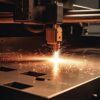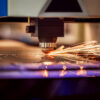In today’s fast-paced manufacturing environment, technology continues to revolutionize how businesses operate. One of the most significant advancements in recent years is the Internet of Things (IoT). IoT is reshaping industries, including laser cutting, by enhancing efficiency, automation, and data-driven decision-making. At Rapid Turn Laser & Machine, we leverage cutting-edge technology to stay ahead of the curve, ensuring our clients receive the highest quality precision cutting services. In this article, we’ll explore what IoT is and how it benefits the laser cutting industry.
What is IoT?
IoT, or the Internet of Things, refers to the network of interconnected devices that communicate and share data over the internet. These devices include sensors, software, and other technologies that collect, analyze, and transmit real-time data. IoT is widely used across multiple industries, from smart homes and healthcare to manufacturing and industrial applications.
In the laser cutting industry, IoT enables machines, sensors, and software to work together seamlessly, optimizing processes and improving overall efficiency. By integrating IoT into laser cutting operations, manufacturers can monitor performance, automate tasks, and ensure higher precision with minimal downtime.
The Benefits of IoT in the Laser Cutting Industry
1. Enhanced Machine Monitoring and Predictive Maintenance
IoT-enabled laser cutting machines are equipped with smart sensors that continuously collect and analyze data on machine performance, temperature, and power consumption. This real-time monitoring helps detect potential issues before they lead to costly breakdowns. Predictive maintenance reduces unplanned downtime, extends equipment lifespan, and minimizes repair costs.
2. Improved Precision and Quality Control
Precision is crucial in laser cutting, especially for industries such as aerospace, automotive, and medical device manufacturing. IoT-enabled systems provide real-time adjustments and feedback mechanisms, ensuring optimal cutting accuracy. By leveraging advanced analytics, manufacturers can identify inconsistencies and correct them in real-time, resulting in higher-quality products.
3. Automation and Smart Manufacturing
IoT facilitates automation by enabling seamless communication between machines and software systems. With smart manufacturing processes, laser cutting operations can be automated, reducing the need for manual intervention. Automated systems improve efficiency, enhance productivity, and reduce human error, ultimately leading to faster production times and cost savings.
4. Real-Time Data Collection and Analytics
One of the most significant advantages of IoT is its ability to collect and analyze vast amounts of data. Laser cutting machines equipped with IoT technology provide real-time insights into operational efficiency, energy consumption, and material usage. This data-driven approach helps businesses make informed decisions, optimize production processes, and reduce waste.
5. Remote Monitoring and Control
IoT allows operators to remotely monitor and control laser cutting machines from any location. Whether on-site or off-site, managers and technicians can access real-time performance data, adjust settings, and troubleshoot issues without being physically present. This remote accessibility enhances operational flexibility and ensures continuous production, even in unforeseen circumstances.
6. Energy Efficiency and Cost Savings
Energy consumption is a major concern in manufacturing. IoT helps monitor and optimize energy usage in laser cutting machines, identifying areas where energy can be conserved. By reducing excessive energy consumption, manufacturers can lower operating costs and contribute to sustainability efforts.
IoT’s Role in Supply Chain and Inventory Management
Beyond optimizing machine performance, IoT also plays a vital role in supply chain and inventory management. By integrating IoT with inventory systems, manufacturers can track material usage, predict shortages, and automate reordering processes. This reduces waste, prevents production delays, and enhances overall workflow efficiency.
Smart warehouses use IoT sensors and RFID technology to track raw materials and finished products in real-time. This level of automation ensures that laser cutting businesses maintain optimal stock levels, reducing the risk of shortages or overstocking.
Case Studies: IoT in Action in the Laser Cutting Industry
Case Study 1: Automotive Industry
A leading automotive manufacturer implemented IoT-enabled laser cutting systems to enhance precision in component manufacturing. By utilizing real-time monitoring and predictive maintenance, the company reduced machine downtime by 30% and improved production efficiency by 25%.
Case Study 2: Aerospace Industry
An aerospace company integrated IoT with its laser cutting processes to ensure ultra-precise cutting for aircraft components. The data collected from sensors allowed the company to make real-time adjustments, leading to a 20% reduction in material waste and an increase in overall component accuracy.
Case Study 3: Medical Device Manufacturing
A medical device manufacturer adopted IoT-driven laser cutting solutions to meet stringent quality control standards. The ability to remotely monitor and adjust machine settings helped maintain consistency, ensuring that each device met regulatory requirements without defects.
The Future of IoT in Laser Cutting
As IoT technology continues to advance, its role in the laser cutting industry will only expand. Future developments may include AI-driven analytics for even greater predictive maintenance, machine learning algorithms that optimize cutting parameters in real-time, and further integration with cloud computing for enhanced data management.
We anticipate that IoT will lead to the development of fully autonomous laser cutting systems, reducing human intervention to an absolute minimum. AI and machine learning will work in tandem with IoT to create self-correcting, highly adaptive laser cutting environments.
Challenges of Implementing IoT in Laser Cutting
While IoT presents numerous benefits, its implementation does come with challenges. These include:
- High Initial Costs: Integrating IoT into laser cutting operations requires significant investment in sensors, connectivity, and software.
- Cybersecurity Risks: With more devices connected online, manufacturers must prioritize cybersecurity to protect sensitive data.
- Data Overload: Managing and analyzing vast amounts of data requires robust data processing capabilities and skilled personnel.
Despite these challenges, the long-term benefits of IoT far outweigh the initial investment, making it a worthwhile advancement for laser cutting manufacturers.
Conclusion
The Internet of Things is transforming the laser cutting industry by enhancing machine monitoring, improving precision, enabling automation, and optimizing energy consumption. Businesses that adopt IoT-driven solutions can achieve higher efficiency, lower costs, and superior product quality.
At Rapid Turn Laser & Machine in Houston, Texas, we are dedicated to leveraging these cutting-edge technologies to provide our clients with the best laser cutting services available. Contact us today to learn more about how we can help with your next project!







